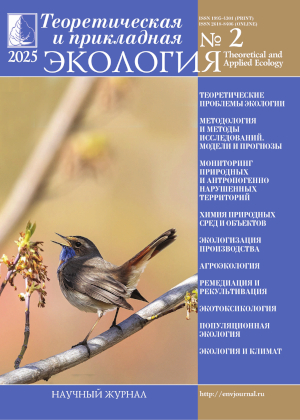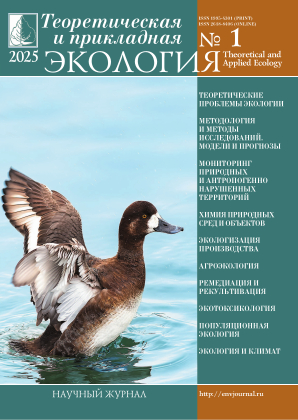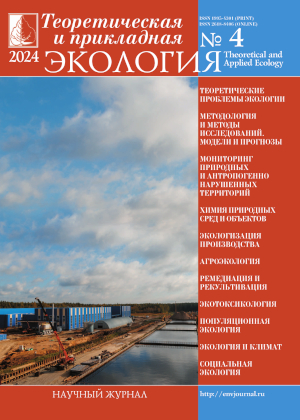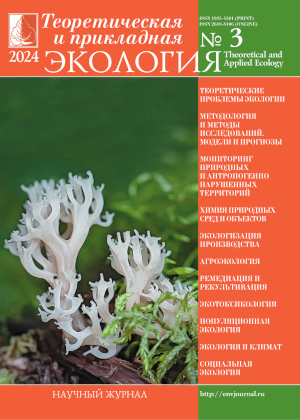 ISSN 1995-4301
ISSN 1995-4301(Print)
ISSN 2618-8406
(Online)
Online version of the journal
|
Assessment of energy, resource saving, environmental, product and economic potential of farm animal products |
||||
| B.V. Ermolenko, M.S. Prutskikh | ||||
| Section: Methodology and research methods. Models and forecasts |
||||
| The paper is devoted to the analysis of environmental problems of farm animal waste management and the energy direction of their use to obtain high-quality organic fertilizers as by-products. The analysis of the population of the main types of farm animals in various regions of the Russian Federation allows us to estimate the annual volumes of formation of their vital products using appropriate specific indicators. This information forms the basis for determining the mass of emissions of various pollutants into the atmosphere (including greenhouse gases), contaminated wastewater into water bodies, waste disposal on agricultural land rejected from circulation in the processes of formation and storage of manure, litter and manure wastewater in livestock farms. The results of the calculations indicate the significance of the environmental damage caused. Calculations were performed using certified techniques and software products. The production of biogas, thermal and electric energy, and high-quality organic fertilizers is chosen as a possible direction of waste disposal in order to reduce their impact on the environment and solve resource-saving problems. The investment design of biogas energy complexes and the development of regional renewable energy development programs require an environmental and economic justification. Its information basis is the system of fuel, electric power, thermal energy, resource-saving, ecological, ecological-economic, economic and product potentials developed by the authors of this paper. A step-by-step methodology for their assessment is presented. Information and computing system created at the Department of Industrial Ecology of the D.I. Mendeleev Russian University of Chemical Technology was used for the assessment. The system is designed to assess the potentials of solar and wind energy, energy use of various types of waste, plant biomass and other types of renewable energy sources. The potentials of energy utilization of farm animal waste products for various types of animal husbandry with differentiation by regions, subjects and federal districts of Russia have been calculated. With this information, each separate administrative-territorial unit can carry out an ecological and economic justification of investment in programs of farm animal waste products utilization. | ||||
| Keywords: farm animals, waste products, assessment, potentials (fuel, electric power, thermal energy, resourcesaving, environmental, economic, product), information and computing system |
||||
| Link | ||||
| Article published in number 4 for 2024 DOI: 10.25750/1995-4301-2024-4-037-048 |
||||
|
||||
On the possibility of using the empirical distribution function to quantify the probability of exceeding the water color standards |
||||
| A.V. Yalaletdinova, M.A. Malkova, L.V. Enikeеva, E.A. Kantor | ||||
| Section: Methodology and research methods. Models and forecasts |
||||
| We found that the nature of the distribution of water color values within a year depends on seasonality. Therefore, to take into account the above, further analysis of the distribution of the indicator was carried out for each month. The analysis of water color distributions for January, May, July and October is given as an example. Variation series were plotted and empirical water color distribution functions were calculated for each month. It is revealed that the laws of water color distribution do not correspond to normal and log-normal distributions, but are approximated quite accurately by polynomials (theoretical distribution function). For the obtained polynomials, the domains of definition of the values of the argument x, at which they have all the properties of the distribution function (continuously increase on the interval [0; 1]) are revealed. The hypotheses about the laws of water color distribution tested using Kolmogorov–Smirnov test were confirmed. The methodology used and the resulting water color distribution functions made it possible to calculate the probabilities of an indicator exceeding the specified values, for example, exceeding the standard (20 degrees) for all months. Thus, in January, the probability of not exceeding the standard will is 0.792, in July – 0.562, in October – 0.809, while in May the probability of not exceeding the water color standard is 0.091. Knowledge of the law of water color distribution, taking into account the seasonal characteristics of the studied process, allows to assess the risks of exceeding normative values by the indicator and to use it for making decisions on ensuring normative water quality in terms of color. | ||||
| Keywords: water quality, water color, empirical distribution function, theoretical distribution function, Kolmogorov–Smirnov test, event probability |
||||
| Article published in number 4 for 2024 DOI: 10.25750/1995-4301-2024-4-073-082 |
||||
|
||||
Possibilities of the biochemiluminiscence method with a model environment from blood serum in assessing the antioxidant activity of plant materials |
||||
| V.A. Kozvonin, E.V. Tovstik, А.А. Maslova, E.B. Dunaeva | ||||
| Section: Methodology and research methods. Models and forecasts |
||||
| Antioxidant activity (AOA) is an important indicator of the evaluation of plant raw materials (RM), which are widely used in medicine to obtain various medicines. The use of RM at the present stage of the pharmaceutical industry development allows avoiding large-scale production of synthetic medicines, accompanied by a negative impact on the environment. For an objective assessment of AOA, it is necessary to apply methods that allow determining not only the content of the active substance, but also generally characterizing the functional activity of RM. The article presents data on the AOA of aqueous extracts from the leaves and fruits of Hippophae rhamnoides L., Aronia melanocarpa L. The determination of antioxidant activity was performed by biochemiluminiscence (BСHL) using serum from white mongrel rats as a model environment (MЕ). The evaluation criteria were the maximum intensity (Imax) and the light sum of the glow (S). The results obtained were compared with the data of the analysis of BCHL without ME, as well as with the data of alternative methods for quantifying the antioxidant potential of RM (coulometric titration, direct titration, spectrophotometry). According to the criteria for assessing the intensity of free radical oxidation (Imax) using the BCHL method without ME, it was found that aqueous extracts from the leaves and fruits of A. melanocarpa, as well as H. rhamnoides leaves, have a high antioxidant potential (343, 274 and 268 mV, respectively), and from H. rhamnoides fruits – more short. BCHL results showed that the amount of radicals in blood serum decreased upon contact with extracts from vegetable raw materials. Among the studied samples, extracts from the fruits of A. melanocarpa were characterized by the highest AOA (S=2006±137 mV·s). At the same time, according to alternative methods, they occupy an intermediate position in terms of the quantitative content of biologically active substances (BAS) with antioxidant properties. Based on the weak correlation between the data of the BСHL method and alternative methods for determining AOA, it is concluded that it is necessary to take into account the possibility of an indirect relationship between the content of BAS in RM and the effect manifested in conditions as close as possible to biological systems. The measurement of AOA by the BСHL method is actually an assessment of the function, as well as the effectiveness of BAS, and complements quantitative met | ||||
| Keywords: biochemiluminiscence, blood serum, Aronia melanocarpa, Hippophae rhamnoides, coulometric titration, direct titration, spectrophotometry |
||||
| Article published in number 3 for 2024 DOI: 10.25750/1995-4301-2024-3-037-044 |
||||
|
||||
Basic approaches to reducing odor pollution of the environment by livestock farms (review) |
||||
| N.V. Syrchina, L.V. Pilip, T.Ya. Ashikhmina | ||||
| Section: Theoretical problems of ecology |
||||
| Modern industrial livestock production is accompanied by emissions into the environment of a wide range of odorforming substances (OFS), which negatively affect the health and quality of life of the population. The problem of protecting atmospheric air from odour pollution (OP) is of high relevance and practical significance. The review critically appraises scientific publications on the control of OP from livestock and poultry farms. Methods of control include the processing of manure with deodorizing materials (reagents, sorbents, enzymes, etc.); inoculation with microorganism strains; adjustment of animal diets; air purification from pollutants; optimization of dispersion; isolation of ОР sources; and odor masking. Agriculture’s focus on adopting green technologies has increased interest in searching environmentally friendly methods of odor control. These are the use of plant extracts, natural sorbents, effective microorganism strains, biofilters, bioscrubbers, biogas plants, planting of protective forest belts that promote the absorption of dust and dispersion of OFS. Each method of OP control has both advantages and disadvantages. Modern “green” methods effectively eliminate odors in large farms, but require high investment and operating costs, which limits their implementation in practice, and relatively low-cost methods (the use of reagents, sorbents, flavoring agents, feed additives) are usually not effective enough. An acceptable result can be obtained by combining various methods of limiting the OFS emission. Control strategies should be selected based on the source of the odor, the effectiveness of the technology on the particular farm, and the cost/benefit ratio of the odor control technology into practice. | ||||
| Keywords: livestock farming, poultry farming, manure, bird droppings, odor, odor reduction methods |
||||
| Article published in number 3 for 2024 DOI: 10.25750/1995-4301-2024-3-006-019 |
||||
|
||||
Characteristics of the Schizophyllum commune new strain EO22 and its ability to degrade polyethylene |
||||
| А.А. Shirokikh, I.G. Shirokikh | ||||
| Section: Population ecology |
||||
| The widespread and possessing extensive biotechnological potential xylotrophic basidiomycete Schizophyllum commune Fr. has a significant genetic variability. This actualizes the study of the fungus various strains to solve a complex of environmental problems, in particular, the disposal of plastic waste. The S. commune strain EO22 used in the work was isolated from rotting Acer negundo wood in the southern taiga subzone of the European Northeast (N58о35´, E49о69´, vicinity of Kirov). It is maintained in mycelial culture in laboratory conditions. The species identification was performed based on the morphology and sequencing result of the ITS1–5.8S–ITS2 fragment nucleotide sequence. The features of the growth and fruiting of mycelial culture EO22 on potato-sucrose and malt agar are described. The degradation potential of the S. commune strain EO22 was established in the experiment on co-incubation with low-pressure polyethylene (HDPE) film. HDPE is one of the most common environmental pollutants (64% of the total plastics production). The process of HDPE biodegradation was carried out exclusively by the dikaryotic type of mycelium and was accompanied by the forming of the fungus fruiting bodies. The results obtained are of interest in connection with the development of technologies for food protein production in the process of plastic waste utilization. | ||||
| Keywords: plastic waste, polyethylene, biodegradation, basidiomycetes |
||||
   |
||||
| Article published in number 3 for 2024 DOI: 10.25750/1995-4301-2024-3-185-191 |
||||
|
||||
Distribution of toxigenic cyanobacteria in water bodies of the East European Plain |
||||
| Т.I. Kutyavina, M.A. Sysolyatina, T.Ya. Ashikhmina | ||||
| Section: Ecotoxicology |
||||
| We analyze the distribution of potentially toxigenic cyanobacteria in water bodies and rivers of the East European (Russian) Plain on the basis of relevant literature and the results of our studies. Special attention is paid to cyanotoxins: microcystins, which are hepatotoxins, cylindrospermopsin, which is hepatotoxin and cytotoxin, and anatoxins and saxi-toxins, which are neurotoxins. Microcystis and Dolichospermum are the most represented genera of potentially toxigenic cyanobacteria, as well as Aphanizomenon flos-aquae Ralfs ex Bornet & Flahault and Planktothrix agardhii (Gomont) Anagnostidis & Komárek species. The above are the most commonly found in water bodies of the study area. The presence of potentially toxigenic cyanobacteria in water bodies was confirmed by the results of phytoplankton studies using molecular genetic methods. The quantitative content of the dissolved in water and intracellular cyanotoxins was determined using enzyme immunoassay methods, high-performance liquid chromatography, and mass spectrometry. It was noted that microcystin- and anatoxin-a-producing cyanobacteria are the most common in most of the studied water bodies and streams, while saxitoxin- and cylindrospermopsin-producing cyanobacteria are less common. The total content of the dissolved microcystins in different water bodies varies from trace amounts up to 1670 μg/L with SanPiN 1.2.3685-21 standard for microcystin-LR 1 μg/L. The maximum recorded anatoxin-a content was 0.600 μg/L. The preparation of this review made it possible to supplement and summarize information on the distribution of toxigenic cyanobacteria and cyanotoxins in rivers, lakes and reservoirs of temperate latitudes, as well as on the quantitative content of cyanotoxins in water. | ||||
| Keywords: water body, cyanobacteria, cyanotoxins, microcystin, saxitoxin, anatoxin, cylindrospermopsin |
||||
| Article published in number 3 for 2024 DOI: 10.25750/1995-4301-2024-3-154-164 |
||||
|
||||
Prospects of hydrogen energy development based on a regional example |
||||
| A.M. Oparina, I.V. Ilyin | ||||
| Section: Ecologization of industry |
||||
| In connection with ongoing climate change, an important factor in the development of the global energy is reducing its carbon footprint. Hydrogen energy may be the answer to the transition to environmentally friendly and resource-saving energy. The article presents an analytical review of promising methods of hydrogen production on the example of the Saratov region, as well as its potential consumers in the real and long term. The review content was selected by analyzing scientific articles published in various databases, electronic scientific libraries and media articles published on the internet. It was concluded that hydrogen produced in the Saratov region will be consumed to a greater extent in the same territory. The production of phosphate fertilizers and the utilization of hydrogen-containing gases in the oil reforming process will be the drivers of hydrogen energy development in the region. In the long term, the use of hydrogen as fuel will be developed. A high-tech autonomous hydrogen energy complex implemented at the Balakovo NPP will be capable of producing and supplying electricity to the electric power system during in the peak hours. It is noted that the Saratov region has the potential to produce biohydrogen obtained by processing agricultural waste. State measures to stimulate hydrogen producers and consumers in the region will play a decisive role in increasing the efficiency of hydrogen energy development in the Saratov region. | ||||
| Keywords: hydrogen energy, alternative energy, biohydrogen, hydrogen, prospects for the use of hydrogen, Saratov region |
||||
| Link | ||||
| Article published in number 3 for 2024 DOI: 10.25750/1995-4301-2024-3-092-101 |
||||
|
||||
Application of adsorption models in the study of nickel ion absorption by soil |
||||
| M.A. Shumilova | ||||
| Section: Methodology and research methods. Models and forecasts |
||||
| The aim of the presented work is to study the absorption of nickel ions by soils of the Udmurt Republic using four sorption models. Humus horizons (0–20 cm) of Albeluvisols Umbric, Leptosols Rendzinic and Phaeozems Albic soils widely distributed in Udmurtia were selected as objects of nickel adsorption research. According to the Langmuir model, good sorbents are characterized by high Amax values and low – KL, therefore, the best sorbent of nickel ions is Albeluvisols Umbric (Amax=0.0562 mol/kg, KL=2075.19 dm3/mol), and a weaker absorber is Phaeozems Albic (Amax=0.0192 mol/kg, KL=19474.48 dm3/mol), Leptosols Rendzinic occupies an intermediate position (Amax=0.0289 mol/kg, KL=14766.47 dm3/mol). The negative value of the Gibbs energy (∆G=–17.97 kJ/mol for Albeluvisols Umbric, –22.59 kJ/mol for Leptosols Rendzinic and –23.24 kJ/mol for Phaeozems Albic) indicates the spontaneous nickel adsorption by soil absorbing complex (SAC). In accordance with the Freundlich model, in all types of studied soils, the nickel ion – SAC binding energy decreases as the surface is filled, herewith the studied soils are characterized by heterogeneity of sorption centers. The approximation coefficient of the Temkin model is in the range of 0.80–0.85, therefore, the discrepancy between the experimental data of the theoretical model indicates the absence of interaction between the adsorbed particles. The Dubinin – Radushkevich model allows us to determine the nature of adsorption forces, as well as the value of the average free energy of adsorption: E=8,325 kJ/mol in Albeluvisols Umbric, 9.5477 kJ/mol in Leptosols Rendzinic and 9.6296 kJ/mol in Phaeozems Albic. Consequently, chemisorption is characteristic of all soils, and proceeds by an ion-exchange mechanism. | ||||
| Keywords: nickel ions, soil, adsorption isotherms, Langmuir model, Freundlich model, Temkin model, Dubinin – Radushkevich model |
||||
| Article published in number 3 for 2024 DOI: 10.25750/1995-4301-2024-3-045-053 |
||||
|
||||
Toxic and biogenic elements in the organs and tissues of the willow ptarmigan (Lagopus lagopus L., 1758) in the north of the Krasnoyarsk Region (review) |
||||
| P.V. Kochkarev, M.A. Perevozchikova, A.A. Sergeev, V.V. Shiryaev, V.N. Piminov | ||||
| Section: Monitoring of natural and anthropogenically disturbed areas |
||||
| Studying the concentration of biogenic and toxic microelements in the body tissues of wild animals is relevant for organizing regional environmental monitoring, assessing the state of populations and ensuring the safety of meat and wild products. The studies were carried out to determine the content of biogenic and toxic elements in the organs and tissues of the willow ptarmigan in the north of the Krasnoyarsk Region, Russia, where different levels of technogenic pollution are expected. The iron, copper, nickel, lead, and cadmium content in the pectoral muscles and liver of willow ptarmigan (Lagopus lagopus L.) (n=162), bagged during five hunting seasons in 2005–2019, were determined using atomic absorption spectrometry. The levels of lead, cadmium and iron in the tissues were significantly higher in contaminated areas, while the copper levels did not differ. Element concentrations in liver and skeletal muscle in impact areas were highly correlated with each other. This may be related to common sources of pollutant emissions. Sex differences in micronutrient content can be determined by spatial differentiation of the sexes during migration, seasonal feeding patterns, and the specific birds’ metabolism in reproductive period. Cadmium and lead content in liver and muscle tissue samples from impact areas exceeded current food hygiene standards, which may pose a threat to consumers. Probably, high levels of lead and cadmium reflect the increased content of metals in food items primarily willow sprouts and buds, which are the most important winter food for ptarmigan. | ||||
| Keywords: willow ptarmigan, trace elements, heavy metals, pollution, lead, cadmium, copper, ecotoxicology, hunting, game meat |
||||
| Article published in number 3 for 2024 DOI: 10.25750/1995-4301-2024-3-054-063 |
||||
|
||||
The logging equipment effect on the dynamics of natural reforestation of after cutting mixed coniferous-deciduous stand in the middle taiga |
||||
| I.N. Kutyavin, A.V. Manov, V.V. Starcev, A.A. Dymov | ||||
| Section: Remediation and rehabilitation |
||||
| The work presents the results of experimental studies on assessment of preliminary and subsequent reforestation depending on the disturbance of the soil cover by logging equipment. The initial survey of the reforestation in the clearing showed the uneven settlement of the territory by woody plants in most parts and individual technological elements. According to morphological characteristics and a set of soil genetic horizons, the soil can be classified as typical Albic Retisols, which develop on loamy soil-forming rocks in well-drained landscapes. We found that the soil of the skidding trail is morphologically close to the original soil. The drag soils have undergone both morphological and chemical changes. The key difference is the change in the composition of the organic horizon following the arrival of a large amount of felling residues and changes in the composition of the ground cover plants. The morphometric parameters of the trees in the mixed stand and undergrowth are of high lability. The stand was dominated by small trees and small undergrowth. The stand and undergrowth are characterized as “healthy”. Relatively good uniformity of its settlement by woody plants was revealed only on portages in ruts with a predominant regeneration of small-leaved species. When the trails are heavily littered, there is no appearance of woody plants. There is no regeneration in the reclaimed felling areas in the first and second years. There is no resumption in sections with aligned tracks in the first and second year. | ||||
| Keywords: mixed stands, cuttings, size structure, natural reforestation |
||||
| Article published in number 3 for 2024 DOI: 10.25750/1995-4301-2024-3-123-132 |
||||
|
Pages: previous 1 2 3 4 5 6
|
36, Moskovskya street, Kirov, 610000, Editorial Board "Theoretical and Applied Ecology." Phone/fax: (8332) 37-02-77 e-mail: envjournal@vyatsu.ru The journal was founded in 2007 |
||||||




 Select viewing options
Select viewing options